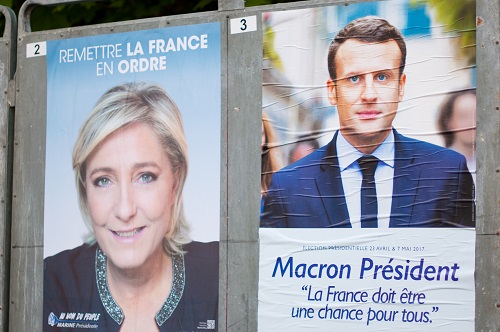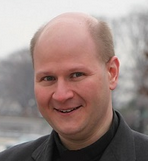
Emmanuel Macron may have won the first round of the French presidential elections on Sunday, but Marine Le Pen won a political victory of her own. The statist undercurrent running through her nationalist and populist policies successfully bridged the gap between France’s “far-Right” and socialist Left, according to Marco Respinti in a new essay for Religion & Liberty Transatlantic.
Mainstream French politicians have sought to combine disparate ideological strands since at least Charles de Gaulle, who presented his foreign policy as a via media between les deux hégémonies – the two Cold War superpowers of the U.S. and USSR. Modern neo-fascist organizations worldwide have (rightly) distanced themselves from the term “conservative,” since it implies a colorblind meritocracy and economic policies that allow minorities to advance in society. They have instead sought to present themselves as a “third position,” whose desire to harness state power for the volk overlap with socialists’ desire to do so for the proletariat. Respinti writes:
Marine’s new strategy bears the old name of “breaching into the Left,” a classical feature of the European nationalist (so-called) Right – and a highly revealing one. In the second half of the twentieth century, European neo-fascist movements and groups have grown steadily dissatisfied with being labelled “rightist” by media and political opponents because of the association of the term “Right” with capitalism, Atlanticism, and a generally warm embrace of the United States and even Israel. (In Italy, the term also indicates monarchism.) Over the years, these groups branded themselves a “third force.” During the Cold War, they assured voters they were “neither with the Soviets, nor with America.” Such “far-Right” economic nationalist and populist movements ‒ which were by no means less statist than their fascist forebears – struggled to gain credibility as “differently leftist.”
Of the many attempts to transform quasi-fascist parties into a brand of nationalism that spans the entire political spectrum, the French FN is the most successful. Winning its bet, it has enlarged its electoral base and appeal. It has gained national momentum. It has made immigration its defining political theme. And it has successfully breached into the Left.
That blending of Left and “Right,” Respinti says, is embodied in National Front vice president Florian Philippot. Raised in a family that voted for Socialist President François Mitterand, he worked for ex-socialist Jean-Pierre Chevènement who founded the Republican and Citizen Movement:
In French, this is part of what is known as la Gauche souvraniste, or the “Sovereignist Left.” In France “souvranisme” is the self-selected label by which all varieties of nationalists have banded together for years. It started as an opposition to the European Union’s internationalism and developed into a philosophy of “neither Left, nor Right.” It proposes both nationalist and socialist policies that would further ensnare France’s democratic institutions in its long political tradition of nationalization and statism. Those proposals are necessary, as there is no other way to possibly keep together such different political pedigrees and ideological sentiments as one can find in the National Front of France, or the separatist Lega Nord of Italy, or Italy’s Five Star Movement (Movimento 5 Stelle). “Souvranisme” lures the masses by promising “change,” and its only strength is the critique of the status quo. As long as people like Marine Le Pen can blame all societal problems on the euro, immigration, and, yes, the free market, votes will come.
During the campaign, Le Pen promised to maintain the 35-hour work week, lower the retirement age to 60, and not reduce the nation’s tax on wealth (N.B.: not merely income). She would increase some welfare benefits. While Le Pen’s second tier of support is likely to be drawn from Fillon’s supporters, her policies are more closely aligned with Jean-Luc Mélenchon, the Communist-supported admirer of Venezuelan socialism who regards the EU as intolerably laissez-faire.
Sunday’s voting ended in a virtual four-way tie. (Macron won 24 percent of the vote, compared to 21 for Le Pen, and roughly 20 percent each for conservative François Fillon and leftist Jean-Luc Mélenchon). Polls show Macron crushing Le Pen, but her campaign is reaching out for the far-Left. Immediately following the election Le Pen’s economic adviser, Philippe Murer, said, “There are people who voted Mélenchon and can now vote for us.” The New Stateman notes that “a spokesperson for the FN [has] pointed out there are remarkable congruities between their respective platforms, which can be categorised as a populism of the left and a populism of the right.”
The phenomenon of allegedly “far-Right” organizations trying to is not unknown in the United States. Conversely Lyndon LaRouche, a onetime Marxist (of French heritage, no less), “breached into the Right” by aligning his movement with Liberty Lobby and anti-Semitic organizations in the 1970s and ‘80s. Plus ça change, plus c’est la même chose.
Perhaps the undertaking is less an example of politically opportunism than a recognition of ideological kinship.
You may read Marco Respinti’s full essay here.
(Photo credit: Guillaume Destomes/Shutterstock.)

